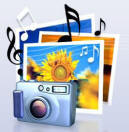
What it is
Storytelling happens in many ways. Novels tell stories, as do short stories, movies and audio books. People tell stories as well. Many cultures have rich histories of passing down facts, legends, and opinions through oral histories. And there are different types of stories. Some are personal and sequential with a traditional beginning, middle, and end. Other stories are non-linear and may not follow established elements of plot. Joyce’s Ullyses is a good example of this. In Digital Storytelling we are using technology to tell stories. Our stories are visually based. Learners should write the story, gather the images, create the product, and finally share the product. The stories we tell may be literary based, either original
stories or retelling of existing stories, or they may be curriculum based, and not linear, such as locating geometrical shapes that occur naturally in our environment.
Stories are “written” or created in a variety of ways. Learners may be asked to illustrate an event from history, such as The Trail of Tears or an existing story from literature, such as Nathaniel Hawthorne’s (1852) My Kinsman Major Molineaux. Or learners may be asked to tell a story with a collection of items, such as locating and identifying particular deciduous trees or locating and identifying geometric shapes in the architecture of the school.
Pictures are typically gathered using digital cameras or by doing image searches on the Internet using the image search functions at http://yahoo.com or http://google.com. Once images are gathered they may be edited if need be using software such as Photoshop or the online photo editor available at http://picnik.com. Finally the images are organized using a piece of software. PowerPoint, Windows Movie Maker, Windows PhotoStory, and iMovie are some of the pieces of software you may choose to use.
How it relates to learning with technology
Digital Storytelling provides an opportunity for group or individual work. Many classroom students may have to share a camera, but most schools would have the resources for every one in the class to use a computer to collect images using an image search function at search engine website. Digital Storytelling can
be used in every curriculum area, from science classes where students could collect images of different types of cells on the Internet to music classes where students could take pictures of facial expressions to illustrate the use of emotion in music.
While the product of Digital Storytelling might be high on the Cone of Experience (Dale, 1969), the process itself moves further down the cone to provide more substantive and direct experience to the learner. It also provides for a way to use different signals for communication and to control for noise or interference as indicated in Schramm’s (1954) Communication model.
General Technical Issues
1. For projecting an image, image resolution does not need to be higher than 640x480, and, depending on the image, it could even be lower.
2. When doing an Internet image search you will be presented with a page of small, thumbnail images first. Don’t save these because they are too small to use. Click on the image to see the full size image and save that one.
3. When searching for images on the Internet using the image search function on nearly every search engine there is an option to use Safe Mode (Google) or to Filter Search (MSN). These options will help to limit the number of explicit images that may be returned. It may not eliminate them, but it should help to limit them.
4. Images are typically posted in either a graphics interchange format
(.gif) or a joint photographic expert group (.jpg) file. Occasionally you will find a portable network graphic (.png) file. If you will be copying them from the web and pasting them into Power Point this may not matter much. But if you are saving them to a disk to use later then you should remember to leave the file extension alone.
General Class Management Issues
1. Make sure learners cite their image sources on an Internet image search. This teaches the importance of following copyright law and the importance of citing your sources. I practice this myself. Every image used in this website is referenced on the image reference page.
2. This activity can be as long or short as you need it to be. As long as you frame it correctly to the students it can be handled in a single class period.
3. It is possible that your learners could be searching for something innocent and innocuous but end up locating inappropriate images. Make sure that you understand the risks involved in this and make sure that you have procedures and policies in place that promote personal responsibility while still recognizing the realities of the Internet.
Some Examples
Digital Story Telling as a PowerPoint presentation: Visualizing the Blues by Marshall Jones
Digital Story Telling as a Windows Media Video file: Jasper Johns by Angie Clark
Handouts and Tutorials
Window's Movie Maker for Digital Video by Dr. Marshall G. Jones
PowerPoint for Digital Story Telling by Dr. Marshall G. Jones
Useful Links for definitions, examples and resources related to Digital Story Telling
The Center for Digital Story Telling
http://www.storycenter.org/Educational Uses of Digital Story Telling from the University of Houston
http://digitalstorytelling.coe.uh.edu/Elements of Digital Story Telling
http://digitalstorytelling.coe.uh.edu/Free Play Music provides instrumental music that may be used in Digital Story Telling projects
http://freeplaymusic.com/MicroSoft PhotoStory 3 is free and will allow you to create .wmv versions of Digital Story Telling
http://www.microsoft.com/windowsxp/using/digitalphotography/PhotoStory/default.mspx
References
Dale, E. (1969). Audio-visual methods in teaching. New York: Dryden.
Schramm, W. (1954). Procedures and Effects of Mass Communication, in Mass Media and Education, ed. Nelson G. Henry (Chicago: University of Chicago Press.
PAL Home | Podcasting | Video | Digital Story Telling | PowerPoint | Claymation
First posted 10/01/2008. Original material copyright Marshall G. Jones, Winthrop University, 2008.
Use with permission of the author.
http://coe.winthrop.edu/jonesmg/lti/pal